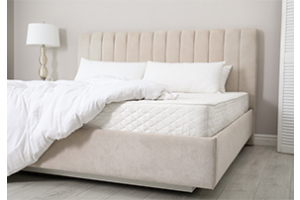Best Beds For Sale - A Buying Guide

Best Beds for Sale: a Buying Guide
As a modern society, we lend much credence to the presence of technology in all facets of life. In fact, and because we’re the most technologically advanced we’ve ever been, it’s that presence of tech in all things that we largely trust to make our lives easier, even better. And when it comes to buying a bed, it’s no longer a task undergone to simply find a slab of foam and material on which to sleep. We look for the tech there too – the springs, the coils, the pillowing. So, let’s look here at a quick guide on what to consider when buying a bed – the types of mattresses out there, and how your own unique sleep requirements can be met, in the mattress you pick.
What Are the Different Types of Mattresses on the Market Today?
Like we mentioned, mattresses are no longer rudimentary sleeping aids. They’re more a vital part of a healthy sleep routine. Here are just some of the available options in mattress design and technology:
Innerspring
Innerspring mattresses are arguably the most common. From pocket coil technology, to offset springs, and a myriad of other designs built into a weight-dispersing mattress for the discerning sleeper, the innerspring is a budget-friendly option in most cases. However, innerspring mattresses can suffer from extra bounce, making them a slightly less desirable option for light sleepers and couples.
Foam
Even the most uninformed of bed buyers will know the illustrious reputation of memory foam – it conjures thoughts of contoured high-comfort, and those thoughts come even if one hasn’t had the privilege of laying one’s body to rest on its marshmallow landscape. Yes, the foam mattress’s reputation precedes it. Although a little higher in price point, foam mattresses of most kinds provide the sleeper with heightened support, that famous snugness in contouring, and that pillowy luxuriousness that’s often the first box that needs to be ticked.
Hybrid
The best of both worlds – hybrid mattresses meld innerspring tech with the comfortability of foam. The latter part of the design, usually incorporated as a pillow top feature, gives the sleeper that luxuriousness, atop a functional, weight-dispersing coil option.
How to Choose a Mattress That's Right for You?
The above are the most common mattress design options available on the market today. However, in looking to determine which may be best-suited to your rest regime, two factors to your unique sleep habits and physiological build, should be considered.
Sleep style
Everyone has their own sleep style. This is the position into which you default naturally when you slumber. This position is a crucial determiner to consider when buying a new bed. So, you could fit specifically, or loosely, into one or a combination of these:
- Side-sleeper – As a side-sleeper, much of the gravitational pressure your body has to bear when horizontal, is concentrated around the shoulders and hips. A plush mattress provides the side-sleeper with both enough cushioning to cradle these touchpoints of pressure, and keep the spine optimally aligned.
- Back-sleeper – As a back-sleeper, too soft a mattress may cause your hips to sink lower than your head, which curves the spine. A plush mattress, again, provides the comfort of a soft mattress, but with enough support to keep the hips, neck and spine supported.
- Stomach-sleeper – If you sleep on your stomach, your spine has to naturally curve, so anything other than a firm mattress may make you toss and turn.
Body Type
Matching your body type with the right mattress firmness will ensure you get the right support in a sleep cycle, and consistently. Here’s how to go about matching your body type to the right mattress type:
- Average bodies- Average body types need average comfortability in a mattress. Make no mistake, though - this doesn’t mean a diminished design in terms of quality. Average comfortability simply means that for the average body, specific hardness or softness isn’t needed – medium mattresses combined with a pillow top option are an ideal fit.
- Flatter bodies- Flat bodies have less weight at crucial pressure points, so they don’t need too much support. In fact, too much weight distribution, like in a firmer mattress, will counteract the body’s natural ability to remain aligned during sleep. So then, a soft mattress is the go-to in this case.
- Curvy bodies- Because of the prominence of pressure points, curvy bodies may sink deeper into mattresses. It’s vital, then, that a good level of firmness be present in that mattress, in order to properly distribute weight evenly. Failing this, the upper body may sink lower than the feet and legs, effectively causing the spine to fall out of alignment. Uneven distribution at these pressure points, and an uneven spine can result in aches, pains, and other medical issues over time.
And there you have it – a concise guide to buying a bed. Dial-a-Bed has options in all firmness levels, in the brands you trust, and at prices to suit your wallet. Once you know the type of mattress you need, visit any of our 76 stores nationwide or shop online 24/7 at www.dialabed.co.za





